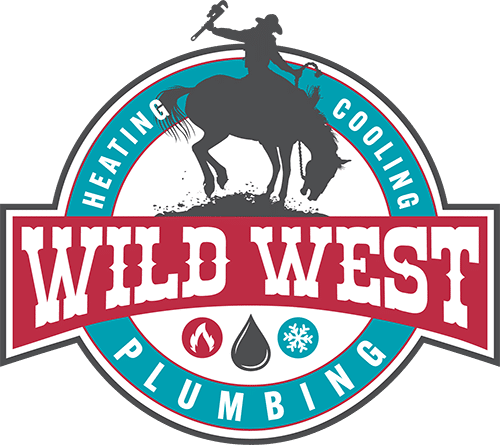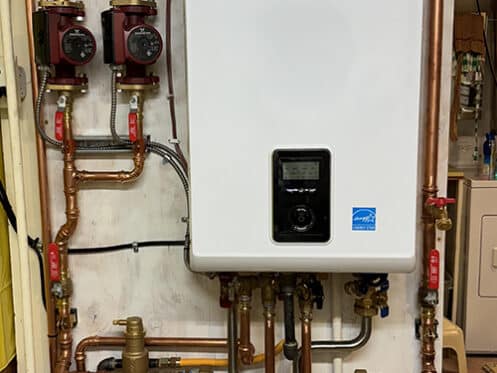No one likes running out of hot water halfway through a shower, especially with a house full of people. That’s where tankless water heaters come in. These systems heat water as you use it, so there’s no bulky tank and no waiting around for it to refill. They’re compact, energy efficient, and built for long-term performance.
No Storage, No Waiting: How Tankless Systems Work Differently
When you think of water heaters, you probably picture that big tank in your garage or basement humming along as it warms up gallons of water. But a tankless system skips that whole process. Instead of heating and storing water, it activates the moment you turn on the tap.
Cold water runs through a heat exchanger, and the system fires up to deliver hot water right away. There’s no reservoir to keep full and no waiting around for the tank to reheat after heavy use.
That can make a huge difference when everyone’s trying to shower in the morning or when the dishwasher and washing machine are running at the same time. You don’t have to shuffle the order or time things just right. The system keeps up, as long as it’s properly sized for your home’s hot water needs. The design is simple, and that simplicity leads to better performance in busy households.
Why Tankless Means Less Waste and Lower Bills
Running a traditional water heater means constantly heating water, whether you use it or not. That storage tank cycles on and off all day and night to maintain its temperature, which adds up on your energy bill.
With a tankless system, you only heat water when you need it. That difference might seem small at first, but over the course of a year, especially in homes with moderate or staggered hot water usage, it can result in meaningful energy savings.
If your routine shifts during the week or you’re away for long stretches, the tankless system simply stays off. That’s one reason energy-conscious homeowners are making the switch. The design trims waste and gives you more control over your energy use.
Space Where You Want It Back
Traditional water heaters take up valuable floor space. You give up part of your closet, garage, or utility room to house a tall metal cylinder that you rarely interact with. With a tankless unit, that space opens back up. These models are wall-mounted and often take up no more room than a carry-on suitcase.
That shift matters when storage is tight or you’re trying to make your space work harder. Whether you want extra shelving or just don’t want to dodge a water heater while doing laundry, the smaller footprint makes a noticeable difference. You also get more flexibility during renovations—you’re not designing around a fixed tank, and you can mount your system wherever it fits best.
Hot Water That Keeps Up With Your Schedule
If you’ve ever had to wait for the hot water to come back or skipped your turn because the tank was empty, this part hits home. Tankless systems don’t run out the way traditional tanks do, as long as the system is correctly sized. Since they heat water on demand, you get a continuous supply even if multiple fixtures are in use.
This is especially helpful when entertaining or hosting overnight guests. You don’t have to warn anyone about “using it all up.” The system adjusts to your flow, not the other way around. Once installed and calibrated for your household’s needs, it’s designed to keep pace with your lifestyle without requiring extra thought.
Less Risk, Fewer Headaches
Traditional water heaters eventually leak, and when they fail, they can spill dozens of gallons across your floor. If you’re not home when it happens, the damage can be significant. Tankless systems don’t hold water in reserve, so the flood risk is greatly reduced.
Of course, any appliance can develop issues, but the absence of a large storage tank means fewer points of failure. That simplicity also makes maintenance more straightforward. A technician can service the components without draining a tank or working around a bulky unit. Just keep in mind that tankless systems do require regular maintenance, typically an annual flush or descaling, especially in areas with hard water.
Longer Lifespan Means Fewer Replacements
If you take care of your tankless unit, it can last several years longer than a traditional water heater. Most standard tanks need replacement every 8 to 12 years. Tankless systems, on the other hand, can operate effectively for 15 to 20 years, especially when properly maintained and supported by good water quality.
While the upfront cost is higher, you make up for it by avoiding frequent replacements. That means fewer plumbing updates and fewer disruptions. If you’re focused on long-term value, it’s a smart investment that gives you peace of mind and scheduling flexibility.
Today’s Tech in Mind
Many modern tankless water heaters include smart features like mobile app connectivity, temperature controls, and energy tracking. Others allow you to schedule operations during off-peak hours, restrict usage at certain times, or run self-cleaning cycles to prevent mineral buildup.
These aren’t gimmicks; they’re built-in tools to help you manage your home more efficiently without needing to fiddle with complicated manuals or settings.
Quiet and Out of Sight
Tankless water heaters are generally quieter than traditional tank units. Without a burner cycling on and off or water sloshing around, the operation noise is minimal. Some gas models may produce a low hum or fan noise, but overall, the unit runs more quietly and discreetly.
Because they’re wall-mounted, they also blend into your space more naturally. Whether installed in a garage, utility room, or cabinet, they don’t draw attention or take up visual real estate.
Upgrade to a Tankless Water Heater Today
Wild West Plumbing, Heating & Cooling has over 35 years of experience in water heater installations. Our NATE-certified technicians also handle water heater repairs and routine maintenance for both tank and tankless systems, so you can count on a reliable supply of hot water year-round.
If you’re ready to explore your plumbing options for an energy-efficient tankless system, give Wild West Plumbing, Heating & Cooling in Kalispell, MT, a call!


